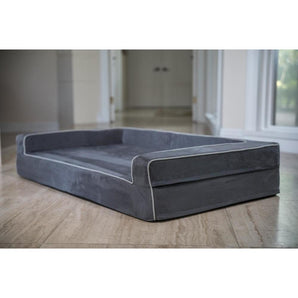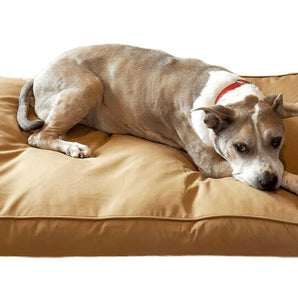Joint pain can occur in all dogs, regardless of age, breed, or size. Since it is difficult to spot, it is important to try to recognize the signs and symptoms then create a treatment plan. If you are noticing that your dog is reluctant to move or they aren't as active as they usually are, with a decrease in physical activity, joint issues may be a problem. If your dog is limping or having spinal issues after walking around for a while, then joint issues may be a problem. Is your dog constantly sleeping with a decrease in appetitive or irritability, then joint issues may be the problem. After you've taken them to the veterinarian to get an official diagnosis, below are few ways you can prevent and treat joint care in your dog.
 Joint Care Prevention- Diet & weight management is crucial for joint care prevention. What that looks like varies based off of the dog’s age and breed. Obesity adds strain on a dog’s joints while a rich diet too early for a puppy can cause them to grow too quickly without allowing their bones to handle the rapid development. Exercise and strengthening helps with joint care prevention. It is important that your dog is getting the proper amount of daily exercise and strengthening based off of their age and breed. Different breeds require different amounts of exercise and strength building. Vet visits are also crucial to joint care prevention. In this blog post, we are going to talk about each of these preventative methods in more detail. Joint Care Supplements- Supplements are crucial to joint care. Whether you are trying to prevent it, or whether you are trying to treat it. So, what are some of the best joint care supplements for dogs? Many veterinarians have a variety of treatments, but most of those supplements contain these ingredients: chondroitin, glucosamine, methylsulfonylmethane (MSM) and omega-3 fatty acids. So, with so many options out there, it is important to choose a supplement that includes these ingredients. The right supplement will help reduce inflammation and pain in their joints. There are all types of supplements out there, so research is key. Even the best supplements aren’t helpful if your dog won’t take them. Joint care soft chews are a popular option and they are the easiest for dogs to take because they resemble dog treats and can be quite tasty. Liquid and joint hip supplements are another option and they are super easy to mix into your dog’s food. They absorb quickly into the body, but you may have to convince your dog to eat the food with the supplement mixed in.
Joint Care Prevention- Diet & weight management is crucial for joint care prevention. What that looks like varies based off of the dog’s age and breed. Obesity adds strain on a dog’s joints while a rich diet too early for a puppy can cause them to grow too quickly without allowing their bones to handle the rapid development. Exercise and strengthening helps with joint care prevention. It is important that your dog is getting the proper amount of daily exercise and strengthening based off of their age and breed. Different breeds require different amounts of exercise and strength building. Vet visits are also crucial to joint care prevention. In this blog post, we are going to talk about each of these preventative methods in more detail. Joint Care Supplements- Supplements are crucial to joint care. Whether you are trying to prevent it, or whether you are trying to treat it. So, what are some of the best joint care supplements for dogs? Many veterinarians have a variety of treatments, but most of those supplements contain these ingredients: chondroitin, glucosamine, methylsulfonylmethane (MSM) and omega-3 fatty acids. So, with so many options out there, it is important to choose a supplement that includes these ingredients. The right supplement will help reduce inflammation and pain in their joints. There are all types of supplements out there, so research is key. Even the best supplements aren’t helpful if your dog won’t take them. Joint care soft chews are a popular option and they are the easiest for dogs to take because they resemble dog treats and can be quite tasty. Liquid and joint hip supplements are another option and they are super easy to mix into your dog’s food. They absorb quickly into the body, but you may have to convince your dog to eat the food with the supplement mixed in.
Joint Care Exercise- It is important that you are keeping your dog fit with exercises that strengthens and stretches their joints. Swimming is an ideal joint exercise for dogs who are already having joint issues. It also helps older dogs who aren’t able to be as active as they once were. Whether it is a hot tub, swimming, or even a bathtub; swimming works wonders for joint care for dogs. Walking at your dog’s pace for at least 10 minutes a day helps immensely with their joint care. It helps lubricate the joints and keep the cartilage healthy. If your dog is unable to do a brisk walk, then a modified version of rolling a ball to them or tugging on a rug or toy, has the same affect. It’s important to find what works best for you and your dog.
Joint Care Vet Visits- As a dog parent, vet visits can be scary. It is important to go into the visits with a list of symptoms and questions for a proper diagnosis. Since joint pain is subtle and difficult to diagnose, you will need to be thorough with the veterinarian to ensure that you are covering all of your issues properly. Ask specific questions like, How are my dog’s hips? What is the ideal weight for my dog? What is the required exercise routine for my dog based off of breed and age? What are telltale signs that my dog is experiencing joint pain? What should my dog’s diet look like for possible joint pain?
Joint Care Friendly Diet- As dog lovers, we know what food our dogs love, but do we know what foods could be contributing to weight gain or joint pain? It is important to eliminate fatty proteins out of their diet and make the change towards more lean proteins. Lean proteins support muscles and joints to keep them healthy and at an ideal weight. An ideal weight helps alleviate joint pain. So, it is important to look for foods that contain plenty of fish oil and other sources of glucosamine and chondroitin. It helps to keep your pup’s bones and joints strong and healthy. Also look for food that is free of grains and other common allergens that can increase inflammation or cause digestive issues for your dog. Do extensive research on the food that you are serving your dog to ensure you are helping their joint pain and not hurting it.
Joint Care Friendly Home Environment- Ensuring that your home is set up properly to care for your dog’s joints is essential. Adding things like slip resistant rugs or doggy socks will help dogs with joint issues stabilize themselves on hardwood or vinyl flooring. Supportive bedding is huge when it comes to creating a friendly home environment. If your dog is having joint pain, be sure to get a bed that helps alleviate pain. Having an orthopedic dog bed will support and cushion their joints and make joint care a little easier. Purchasing a dog harness that helps take the weight and pressure off of the joints is another key thing to have in your home environment. Whether it’s just to wear around the house, or to wear on walks around the neighborhood, a harness can be super helpful for joint care in older dogs.
Joint Care Massages- Dog massages are a good way to prevent joint pain and also care for joint pain. There are simple dog massages that you can do from home to relax and strengthen those joint muscles. It is important that you pay attention to your dog and their signals. If they don’t want to be touched, then don’t force it. Don’t try the massaging method right after they’ve eaten. Give their food time to digest. There are three different types of massages are effleurage, petrissage, and compression massages that are usually done on humans, but you can do them on your dog as well. With an effleurage, you are doing a soothing circular stroking movement with the palm of your hand to “wake” up the muscles. With a petrissage message, you are using a kneading technique with your fist and hand while applying pressure and compressing the underlying muscles. With a compression massage, it’s an open hand technique in a rhythmic motion that presses the belly of the muscle again the bone to release tension and create muscle relaxation. Your dog may not be completely comfortable with you massaging them at first, but that comfort will come with time and consistency. Be sure to employ these methods 2-3 times a week for at least 5 minutes.
Joint Care Surgery- No one wants to have to get joint care surgery for their dog, but sometimes it resorts to this option. Luckily there are evasive and non-evasive options available, but it’s best to talk to your veterinarian about the options available for your dog’s age and breed. Don’t panic about the need for surgery, just try to inform yourself as much as possible when it comes to your dog’s joint care surgery. Some non-invasive options include an orthopedic brace, physical therapy or medication. An orthopedic brace is a good option because it’s not as expensive as surgery and it’s available for your dog’s knee, hips, wrist, or hock. Physical therapy is a good non-invasive option and your veterinarian should be able to recommend someone who will help work through your dog’s joint pain with you. Medications are another alternative for joint pain, just ensure that you are using nonsteroidal anti-inflammatory drugs, or NSAIDs because they can help with swelling, stiffness, and joint pain.
We know you care for your dog. We do too! The best method of joint care is prevention. Make sure that you are making small preventative steps in the beginning so you can avoid costly surgery on your best friend later down the road. Joint issues in your dog that go unnoticed or unattended to can only make things worse as they get older. Be sure to pay attention to issues that may arise as soon as they happen. Make sure you are paying attention to their patterns and moods to get ahead of joint issues. Regardless of your method of caring for your dog’s joint pain, make sure that you are informed and proactive so you can keep them in the best health possible.




